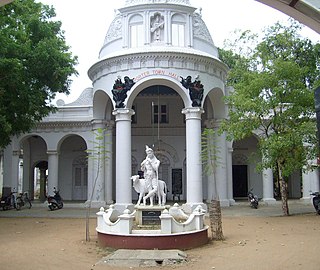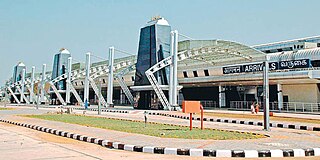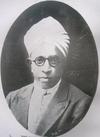
Kumbakonam is a town and a special grade municipality in the Thanjavur district in the Indian state of Tamil Nadu. It is located 40 km (25 mi) from Thanjavur and 273 km (170 mi) from Chennai and is the headquarters of the Kumbakonam taluk of Thanjavur district. The town is bounded by two rivers, the Kaveri River to the north and Arasalar River to the south. Kumbakonam is known as a "temple town" due to the prevalence of a number of temples here and is noted for its Mahamaham festival which attracts people from all over the country.

Tiruchirappalli, also called Tiruchi or Trichy, is a major tier II city in the Indian state of Tamil Nadu and the administrative headquarters of Tiruchirappalli district. The city is credited with being the best livable city and the cleanest city of Tamil Nadu, as well as the fifth safest city for women in India. It is the fourth largest city as well as the fourth largest urban agglomeration in the state. Located 322 kilometres (200 mi) south of Chennai and 374 kilometres (232 mi) north of Kanyakumari, Tiruchirappalli sits almost at the geographic centre of the state. The Cauvery Delta begins 16 kilometres (9.9 mi) west of the city where the Kaveri river splits into two, forming the island of Srirangam which is now incorporated into the Tiruchirappalli City Municipal Corporation. The city occupies an area of 167.23 square kilometres (64.57 sq mi) and had a population of 916,857 in 2011.

Thomas Caverhill Jerdon was a British physician, zoologist and botanist. He was a pioneering ornithologist who described numerous species of birds in India. Several species of plants and birds including Jerdon's baza, Jerdon's leafbird, Jerdon's bushlark, Jerdon's nightjar, Jerdon's courser, Jerdon's babbler and Jerdon's bush chat are named after him.

The Madras Presidency, or the Presidency of Fort St. George, also known as Madras Province, was an administrative subdivision (presidency) of British India. At its greatest extent, the presidency included most of southern India, including the whole of the Indian state of Tamil Nadu, and parts of Andhra Pradesh, Kerala, Karnataka, Telangana, Odisha and the union territory of Lakshadweep. The city of Madras was the winter capital of the Presidency and Ootacamund or Ooty, the summer capital. The Island of Ceylon was a part of Madras Presidency from 1793 to 1798 when it was created a Crown colony. Madras Presidency was neighboured by the Kingdom of Mysore on the northwest, Kingdom of Cochin on the southwest, and the Kingdom of Hyderabad on the north. Some parts of the presidency were also flanked by Bombay Presidency (Konkan) and Central Provinces and Berar.

Chennai, formerly known as Madras, is the capital of the state of Tamil Nadu and is India's fifth largest city. It is located on the Coromandel Coast of the Bay of Bengal. With an estimated population of 8.9 million (2014), the 400-year-old city is the 31st largest metropolitan area in the world.

Tiruchirappalli International Airport is an international airport serving Tiruchirappalli in the state of Tamil Nadu, India. It is located on National Highway 336, about 5 km (3.1 mi) south of the city centre . As of FY 2019-20 it is 31st busiest airport in India for passengers handled and 34th busiest for total aircraft movement, It is the third busiest airport within Tamil Nadu in terms of total passenger traffic next to Chennai. The airport is served by three Indian and four foreign carriers providing direct connectivity to 5 domestic and 7 international destinations.The airport covers an area of 998 acres. The airport is ISO 9001:2008 quality certified and was declared an international airport on 4 October 2012.

Pudukkottai was a kingdom and later a princely state in British India, which existed from 1680 until 1948.

Tiruvengimalai Sesha Sundara Rajan (1880–1953) was an Indian doctor, politician and freedom-fighter who served the Minister of Public Health and Religious Endowments in the Madras Presidency from 1937 to 1939.

The Siege of Arcot took place at Arcot, India between forces of the British East India Company led by Robert Clive and forces of Nawab of the Carnatic, Chanda Sahib, assisted by a small number of troops from the French East India Company. It was part of the Second Carnatic War.

M. Muhammad Ismail was an Indian politician and social worker from Tirunelveli, southern Tamil Nadu. He is the founder of Indian Union Muslim League after the partition of British India (1947). He was popularly known in Tamil Nadu and Kerala as the "Quaid-e-Millat".

The Tiruchirappalli City Municipal Corporation is the municipal corporation which looks after the city administration of Tiruchirappalli in Tamil Nadu, India. It consists of a legislative and an executive body. The legislative body is headed by the city mayor while the executive body is headed by a Chief Commissioner.
The Trichinopoly district was a district of the erstwhile Madras Presidency of British India. It covered the present-day districts of Tiruchirappalli, Karur, Ariyalur and Perambalur in the Indian state of Tamil Nadu. The administrative headquarters was the town of Trichinopoly, Trichy or Tiruchi, now known as Tiruchirappalli. The district covered an area of 2,632 square miles (6,820 km2) in 1907. It was bound by the districts of South Arcot to the north, Salem to the west, Coimbatore to the west and north-west, Tanjore to the east and Madurai to the south. The princely state of Pudukkottai remained within the jurisdiction of Trichinopoly district from 1865 to 1947.

Tiruchirappalli is believed to be of great antiquity and has been ruled by the Early Cholas, Mutharaiyars Early Pandyas, Pallavas, Medieval Cholas, Later Cholas, Later Pandyas, Delhi Sultanate, Ma'bar Sultanate, Vijayanagar Empire, Nayak Dynasty, the Carnatic state and the British at different times. The archaeologically important town of Uraiyur which served as the capital of the Early Cholas is a suburb of Tiruchirapalli.
The 1928 South Indian railway strike was a general strike by the South Indian Railway Workers Union against plans of the South Indian Railway Company to lay off over 3,100 workers in order to reduce the expenditures of the company. The strike lasted from 29 June – 2 August 1928, and severely affected the transportation of people and goods across South India. The Madras government and the South Indian Railway Company responded with a crackdown. Most of the leaders of the strike were arrested and recognition to the union was withdrawn.The Government of Madras recorded it as the "most important event of the year".
The South Indian Railway Company operated a number of 1,000 mm gauge lines in South India from 1874 to 1951.

The Duvvada–Vijayawada section is a railway line connecting Duvvada of Visakhapatnam and Vijayawada, both in the Indian state of Andhra Pradesh. The main line is part of the Howrah–Chennai main line. The track from Duvvada to Thadi is under the administrative jurisdiction of South Coast Railway, and the rest of the line from Anakapalle to Vijayawada is under the administrative jurisdiction of South Coast Railway zone headquartered in Visakhapatnam.
Railway Mixed Higher Secondary School, commonly Railway School or RMHSS or RMHS/EM/GOC is a Government coed day school located at Golden Rock, Tiruchirappalli, Tamil Nadu. It is one among 42 schools in the state and among 4 schools in the Tiruchirapalli Revenue district that follows both Anglo-Indian Board of Education and Higher Secondary Board, catering to pupils from Class I to Class XII in bilingual pattern, viz., English and Tamil, which are the medium of instruction.

The Chennai Egmore–Tiruchchirappalli main line connects Chennai Egmore and Thanjavur Junction both in the Indian state of Tamil Nadu. The Chennai Egmore–Thanjavur main line is part of Chennai–Viluppuram–Mayiladuthurai–Kumbakonam–Thanjavur–Tiruchirappalli line. There are several branch lines : Chengalpattu–Arakkonam links to Chennai Central–Bengaluru City line, Guntakal–Chennai Egmore section, Viluppuram–Puducherry, Cuddalore–Virudhachalam, Mayiladuthurai–Thiruvarur, and Peralam–Nagapattinam sectors. The line connects the Kaveri delta to Chennai.
Events in the year 1867 in India.
This is the timeline for Southern Railway zone that encompasses over present day Tamil Nadu, Kerala and parts of Andhra Pradesh and Karnataka.